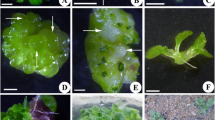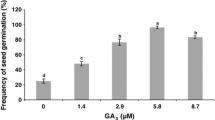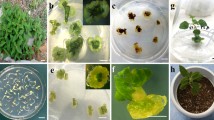Abstract
Different explants of Miscanthus x ogiformis Honda ‘Giganteus’ were tested in order to develop an efficient tissue culture system. Shoot apices, leaf and root sections from in vitro-propagated plants, and leaf and immature inflorescence sections from 6-month-old greenhouse-grown plants were used. The explants were cultured on Murashige and Skoog medium supplemented with 4.5, 13.6, 22.6 or 31.7 μM 2,4-dichlorophenoxyacetic acid. Three types of callus were formed but only one was embryogenic and regenerated plants. Callus induction and formation of embryogenic callus depended on the type and developmental stage of the explants. Shoot apices formed the highest percentage of embryogenic callus. There was a difference in the formation of embryogenic callus between leaf explants from in vitro-propagated shoots and greenhouse-grown plants. The best results were obtained from newly formed leaves of in vitro-propagated shoots and older leaves of greenhouse-grown plants. Immature inflorescences smaller than 2.5 cm produced a higher percentage of embryogenic callus than larger more mature inflorescences. Embryogenic callus derived from immature inflorescences had the highest regeneration capacity. Differences in 2,4-dichlorophenoxyacetic acid concentrations had no significant effect on callus induction, embryogenic callus formation and plant regeneration.
Similar content being viewed by others
Abbreviations
- MS:
-
Murashige & Skoog
- 2,4-d :
-
2,4-dichlorophenoxyacetic acid
- BA:
-
benzyladenine
- NAA:
-
1-naphthaleneacetic acid
- PPFD:
-
photosynthetic photon flux density
References
Barcelo P, Lazzeri PA, Martin A & Lörz H (1991) Competence of cereal leaf cells. I. Patterns of proliferation and regeneration capability in vitro of the inflorescence sheath leaves of barley, wheat and tritordeum. Plant Sci. 77: 243–251
Barcelo P, Lazzeri PA, Martin A & Lörz H (1992) Competence of cereal leaf cells. II. Influence of auxin, ammonium and explant age on regeneration. J. Plant Physiol. 139: 448–454
Bhaskaran S & Smith RH (1988) Enhanced somatic embryogenesis in Sorghum bicolor from shoot tip culture. In Vitro Cell. Dev. Biol. 24: 65–70
Bhaskaran S & Smith RH (1990) Regeneration in cereal tissue culture: A review. Crop Sci. 30: 1328–1336
Brettell RIS, Wernicke W & Thomas E (1980) Embryogenesis from cultured immature inflorescences of Sorghum bicolor. Protoplasma 104: 141–148
Cai T & Butler L (1990) Plant regeneration from embryogenic callus initiated from immature inflorescences of several high-tannin sorghums. Plant Cell Tiss. Org. Cult. 20: 101–110
Carman JG (1990) Embryogenic cells in plant tissue cultures: Occurrence and behavior. In Vitro Cell. Dev. Biol. 26: 746–753
Carnes MG & Wright MS (1988) Endogenous hormone levels of immature corn kernels of A188, Missouri-17, and Dekalb XL-12. Plant Sci. 57: 195–203
Creemers-Molenaar J, Loeffen JPM & Van DerValk P (1988) The effect of 2,4-dichlorophenoxyacetic acid and donor plant environment on plant regeneration from immature inflorescence-derived callus of Lolium perenne L. and Lolium Multiflorum L. Plant Sci. 57: 165–172
Dale PJ, Thomas E, Brettell RIS & Wernicke W (1981) Embryogenesis from cultured immature inflorescences and nodes of Lolium multiflorum. Plant Cell Tiss. Org. Cult. 1: 47–55
Guiderdoni E & Demarly Y (1988) Histology of somatic embryogenesis in cultured leaf segments of sugarcane plantlets. Plant Cell Tiss. Org. Cult. 14: 71–88
Ho W & Vasil IK (1983) Somatic embryogenesis in sugarcane (Saccharum officinarum L.) I. The morphology and physiology of callus formation and the ontogeny of somatic embryos. Protoplasma 118: 169–180
lewandowski I & Kahnt G (1993) Möglichkeiten zur Erstellung eines In-vitro-Vermehrungssystems für Miscanthus ‘Giganteus’ durch Nutzing vershiedener Pflanzenteile als Spendergewebe. Bodenkultur 44: 243–252
Linacero R & Vázquez AM (1986) Somatic embryogenesis and plant regeneration from leaf tissues of rye (Secale cereale L.). Plant Sci. 44: 219–222
Linde-Laursen I (1993) Cytogenetic analysis of Miscanthus ‘Giganteus’, an interspecific hybrid. Hereditas 119: 297–300
Lu C & Vasil IK (1981) Somatic embryogenesis and plant regeneration from leaf tissues of Panicum maximum Jacq. Theor. Appl. Genet. 59: 275–280
Lörz H, Göbel E & Brown P (1988) Advances in tissue culture and progress towards genetic transformation of cereals. Plant Breed. 100: 1–25
Maddock SE, Lancaster VA, Risiott R & Franklin J (1983) Plant regeneration from cultured immature embryos and inflorescences of 25 cultivars of wheat (Triticum aestivum). J. Exp. Bot. 34: 915–926
Morrish F, Vasil V & Vasil IK (1987) Developmental morphogenesis and genetic manipulation in tissue and cell cultures of the gramineae. Adv. Genet. 24: 431–499
Murashige T & Skoog F (1962) A revised medium for rapid growth and bio assays with tobacco tissue cultures. Physiol. Plant. 15: 473–497
Nielsen PN (1987) Vegetativ formering af elefantgræs, Miscanthus sinensis ‘Giganteus’. Tidsskr. Planteavl 91: 361–368
Nielsen JM, Brandt K & Hansen J (1993) Long-term effects of thidiazuron are intermediate between benzyladenine, kinetin or isopentenyladenine in Miscanthus sinensis. Plant Cell Tiss. Org. Cult. 35: 173–179
Nielsen JM, Hansen J & Brandt K (1995) Synergism of thidiazuron and benzyladenine in axillary shoot formation depends on sequence of application in Miscanthus x ogiformis ‘Giganteus’. Plant Cell Tiss. Org. Cult. 41: 165–170
Pareddy DR & Petolino JF (1990) Somatic embryogenesis and plant regeneration from immature inflorescences of several elite inbreds of maize. Plant Sci. 67: 211–219
Petersen KK & Holme I (1992) Preliminary results concerning induction of somatic embryogenesis in Miscanthus x ogiformis ‘Giganteus’. Cost 87. Report of the 1992 activities, 148–149
Rajasekaran K, Hein MB, Davis GC, Carnes MG & Vasil IK (1987a) Endogenous growth regulators in leaves and tissue cultures of Pennisetum purpureum Schum., J. Plant Physiol. 130: 13–25
Rajasekaran K, Hein MB & Vasil IK (1987b) Endogenous abscisic acid and indole-3-acetic acid and somatic embryogenesis in cultured leaf explants of Pennisetum purpureum Schum.: Effects in vivo and in vitro of glyphosate, fluridone and paclobutrazol. Plant Physiol. 84: 47–51
Ruíz ML, Rueda J, Peláez MI, Espino FJ, Candela M, Sendino AM & Vázquez AM (1992) Somatic embryogenesis, plant regeneration and somaclonal variation in barley. Plant Cell Tiss. Org. Cult. 28: 97–101
SAS Institute Inc. (1993) SAS Technical Report P-243. SAS/STAT Software: The GENMOD Procedure. Release 6.09. SAS Institute Inc. Cary, NC, p. 88
Schwarz H, Liebhard P, Ehrendorfer K & Ruckenbauer P (1994) The effect of fertilization on yield and quality of Miscanthus sinensis ‘Giganteus’. Industrial Crops and Products 2: 153–159
Tabaeizadeh Z, Plourde A & Comeau A (1990) Somatic embryogenesis and plant regeneration in Triticum aestivum x Leymus angustus F1 hybrids and the parental lines. Plant Cell Rep. 9: 204–206
Thomas MR & Scott KJ (1985) Plant regeneration by somatic embryogenesis from callus initiated from immature embryos and immature inflorescences of Hordeum vulgare. J. Plant Physiol. 121: 159–169
Vasil IK (1987) Developing cell and tissue culture systems for the improvement of cereal and grass crops. J. Plant Physiol. 128: 193–218
Vasil V & Vasil IK (1986) Plant regeneration from friable embryogenic callus and cell suspension cultures of Zea mays L. J. Plant Physiol. 124: 399–408
Wenck AR, Conger BV, Trigiano RN & Sams CE (1988) Inhibition of somatic embryogenesis in orchard grass by endogenous cytokinins. Plant Physiol. 88: 990–992
Wernicke W & Brettell R (1980) Somatic embryogenesis from Sorghum bicolor leaves. Nature 287: 138–139
Wernicke W, Brettell R, Wakizuka T & Potrykus I (1981) Adventitious embryoid and root formation from rice leaves. Z. Pflanzenphysiol. 103: 361–365
Wernicke W & Milkovits L (1984) Developmental gradients in wheat leaves-Response of leaf segments in different genotypes cultured in vitro. J. Plant Physiol. 115: 49–58
Wernicke W & Milkovits L (1986) The regeneration potential of wheat shoot meristems in the presence and absence of 2,4-dichlorophenoxyacetic acid. Protoplasma 131: 131–141
Author information
Authors and Affiliations
Rights and permissions
About this article
Cite this article
Holme, I.B., Petersen, K.K. Callus induction and plant regeneration from different explant types of Miscanthus x ogiformis Honda ‘Giganteus’. Plant Cell Tiss Organ Cult 45, 43–52 (1996). https://doi.org/10.1007/BF00043427
Received:
Accepted:
Issue Date:
DOI: https://doi.org/10.1007/BF00043427




